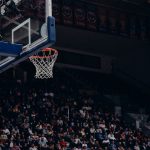Dribbling is a fundamental skill in basketball that requires precision, control, and agility. There are several dribbling drills that players can practice to improve their ball-handling skills. One effective drill is the “Cone Dribble Drill,” where players set up cones in a straight line and dribble the ball in and out of the cones using both hands.
This drill helps players improve their ability to maneuver through defenders and maintain control of the ball. Another useful dribbling drill is the “Figure 8 Dribbling Drill,” where players dribble the ball in a figure 8 pattern around two cones. This drill helps players develop hand-eye coordination and ambidexterity in their dribbling skills.
By practicing these dribbling drills regularly, players can enhance their ability to protect the ball, change direction quickly, and create scoring opportunities for themselves and their teammates. In addition to the cone and figure 8 dribbling drills, players can also benefit from the “Two-Ball Dribbling Drill.” This drill involves dribbling two basketballs simultaneously while moving around the court. This challenging drill helps players improve their coordination, speed, and ball-handling skills.
Another effective dribbling drill is the “Full-Court Dribbling Drill,” where players practice dribbling the ball at full speed from one end of the court to the other. This drill helps players develop their stamina, speed, and control under pressure. By incorporating these various dribbling drills into their training routine, players can become more confident and proficient in their ability to handle the ball in game situations.
Key Takeaways
- Dribbling Drills: Focus on control and speed, practice different moves and change of direction
- Shooting Drills: Work on form, accuracy, and different types of shots (layups, jump shots, etc.)
- Passing Drills: Emphasize accuracy, timing, and different types of passes (chest pass, bounce pass, etc.)
- Defensive Drills: Practice stance, footwork, and communication with teammates
- Footwork Drills: Improve agility, balance, and coordination for better movement on the court
- Rebounding Drills: Work on positioning, timing, and boxing out techniques
- Teamwork Drills: Focus on communication, coordination, and understanding of teammates’ movements
Shooting Drills
Developing Shooting Range and Mechanics
One popular shooting drill is the “Spot Shooting Drill,” where players move around the key and perimeter, taking shots from various spots on the court. This drill helps players develop their shooting range, footwork, and shooting mechanics.
Improving Free Throw Shooting
Another effective shooting drill is the “Free Throw Shooting Drill,” where players practice shooting free throws from the charity stripe. This drill helps players improve their concentration, form, and consistency from the free-throw line.
Enhancing Close-Range and Long-Range Shooting
In addition to spot shooting and free throw drills, players can also benefit from the “Mikan Drill,” which focuses on layup and close-range shooting. This drill involves players alternating layups with both hands under the basket, helping them develop their touch and finishing ability around the rim. Another useful shooting drill is the “3-Point Shooting Drill,” where players practice shooting from beyond the arc to improve their long-range accuracy and confidence.
By incorporating these shooting drills into their training regimen, players can enhance their scoring ability, become more versatile shooters, and contribute more effectively to their team’s offensive success.
Passing Drills

Passing is an essential skill in basketball that requires vision, timing, and accuracy. There are several passing drills that players can practice to improve their passing skills and become more effective playmakers on the court. One valuable passing drill is the “Partner Passing Drill,” where players work with a teammate to practice various types of passes, such as chest passes, bounce passes, and overhead passes.
This drill helps players develop their communication, hand-eye coordination, and passing accuracy. Another beneficial passing drill is the “Outlet Passing Drill,” where players practice making quick outlet passes to initiate fast breaks and transition opportunities. This drill helps players improve their decision-making, awareness, and ability to advance the ball up the court.
In addition to partner passing and outlet passing drills, players can also benefit from the “Circle Passing Drill,” which focuses on ball movement and player movement off the ball. This drill involves players passing the ball around a circle while moving to different spots on the court, helping them develop their passing angles, timing, and court awareness. Another useful passing drill is the “Wraparound Passing Drill,” where players practice making wraparound passes around a defender to simulate game-like passing situations.
By incorporating these passing drills into their training routine, players can become more adept at creating scoring opportunities for their teammates and executing precise passes in game situations.
Defensive Drills
| Drill Name | Objective | Equipment Needed | Duration |
|---|---|---|---|
| Shell Drill | Improving team defensive positioning | Cones | 15 minutes |
| Closeout Drill | Developing closeout speed and technique | Basketball | 10 minutes |
| 3-on-3 Cutthroat | Enhancing communication and help defense | Basketball, cones | 20 minutes |
Defense is a critical aspect of basketball that requires focus, effort, and technique. There are several defensive drills that players can utilize to improve their defensive skills and become more effective defenders on the court. One valuable defensive drill is the “Closeout Drill,” where players practice closing out on shooters and contesting shots with proper defensive stance and technique.
This drill helps players improve their footwork, positioning, and ability to challenge shots without fouling. Another effective defensive drill is the “Shell Drill,” where players work on team defense principles such as help-side defense, communication, and rotations. This drill helps players develop their defensive awareness, teamwork, and ability to defend against various offensive actions.
In addition to closeout and shell drills, players can also benefit from the “Defensive Slides Drill,” which focuses on lateral movement and on-ball defense. This drill involves players sliding back and forth across the court while maintaining a defensive stance and mirroring the movements of an offensive player. This drill helps players improve their agility, balance, and ability to stay in front of their man defensively.
Another useful defensive drill is the “Charge Drill,” where players practice taking charges and drawing offensive fouls by establishing position and absorbing contact. By incorporating these defensive drills into their training regimen, players can become more disciplined, tenacious defenders who can make a significant impact on the defensive end of the court.
Footwork Drills
Footwork is a fundamental aspect of basketball that impacts a player’s ability to move effectively on the court, create space, and maintain balance. There are several footwork drills that players can practice to improve their agility, balance, and coordination. One valuable footwork drill is the “Jump Stop Drill,” where players practice coming to a quick jump stop with both feet simultaneously to maintain balance and prepare for a shot or pass.
This drill helps players develop their body control, balance, and ability to transition from movement to a stationary position efficiently. Another effective footwork drill is the “Pivot Drill,” where players work on various pivot moves such as front pivots, reverse pivots, and step-through moves to create space and protect the ball. This drill helps players improve their footwork in tight spaces and under defensive pressure.
In addition to jump stop and pivot drills, players can also benefit from the “Ladder Drill,” which focuses on quickness, coordination, and change of direction. This drill involves players moving through a ladder pattern on the court with precise footwork and timing to improve their agility and explosiveness. Another useful footwork drill is the “Defensive Footwork Drill,” where players work on defensive slides, closeouts, and stance to improve their ability to stay in front of their man defensively.
By incorporating these footwork drills into their training routine, players can become more agile, balanced athletes who can move effectively on both ends of the court.
Rebounding Drills

Developing Positioning and Strength with the Box Out Drill
One valuable rebounding drill is the “Box Out Drill,” where players practice establishing position and blocking out an opponent to secure rebounds. This drill helps players develop their awareness, strength, and technique in gaining inside position for rebounds.
Improving Second-Chance Scoring with the Tip Drill
Another effective rebounding drill is the “Tip Drill,” where players work on tipping missed shots back into the basket using quick reactions and timing. This drill helps players improve their second-chance scoring opportunities and offensive rebounding prowess.
Enhancing Rebounding Skills with Circle and Outlet Pass Drills
In addition to box out and tip drills, players can also benefit from the “Circle Rebounding Drill,” which focuses on multiple players competing for rebounds in a confined space. This drill involves players battling for rebounds within a designated area while maintaining proper positioning and physicality. Another useful rebounding drill is the “Outlet Pass Drill,” where players practice securing rebounds and making quick outlet passes to initiate fast breaks or transition opportunities. By incorporating these rebounding drills into their training regimen, players can become more aggressive, tenacious rebounders who can control the boards and provide second-chance opportunities for their team.
Teamwork Drills
Teamwork is an essential aspect of basketball that requires communication, trust, and cohesion among teammates. There are several teamwork drills that players can practice to improve their chemistry, coordination, and effectiveness as a unit on the court. One valuable teamwork drill is the “3-on-3 Scrimmage,” where players compete in a half-court setting with an emphasis on ball movement, spacing, and defensive rotations.
This drill helps players develop their teamwork, decision-making, and understanding of offensive and defensive principles in a game-like setting. Another effective teamwork drill is the “Passing Lanes Drill,” where players work on passing angles, timing, and anticipation to move the ball effectively around the court while maintaining spacing. In addition to 3-on-3 scrimmage and passing lanes drills, players can also benefit from the “Transition Offense/Defense Drill,” which focuses on quick transitions from offense to defense and vice versa.
This drill involves simulating fast break opportunities for both teams to work on defensive communication, sprinting back in transition, and offensive spacing in fast-paced situations. Another useful teamwork drill is the “Screening Drill,” where players practice setting screens and using screens effectively to create scoring opportunities for teammates. By incorporating these teamwork drills into their training routine, players can become more cohesive, synchronized as a team who can execute effectively on both ends of the court.
In conclusion, basketball is a dynamic sport that requires a diverse set of skills including dribbling, shooting, passing, defense, footwork, rebounding, and teamwork. By incorporating a variety of drills into their training regimen focused on these fundamental aspects of the game, players can enhance their overall skill set and become more well-rounded athletes who can contribute effectively to their team’s success on the court. Whether it’s improving ball-handling with dribbling drills or developing scoring proficiency with shooting drills or enhancing defensive prowess with defensive drills or refining teamwork with teamwork drills – consistent practice of these fundamental skills will undoubtedly lead to improvement in individual performance as well as team success overall.
If you’re looking for more tips and tricks for beginner basketball drills, check out this article on masonbasketball.com. They offer a variety of resources and drills specifically designed for beginners to help improve their skills on the court. Whether you’re looking to work on shooting, dribbling, or passing, this article has everything you need to get started on your basketball journey.
FAQs
What are basketball drills for beginners?
Basketball drills for beginners are exercises and activities designed to help new players develop fundamental skills such as dribbling, shooting, passing, and defense. These drills are essential for building a strong foundation in basketball.
Why are basketball drills important for beginners?
Basketball drills are important for beginners because they help players develop essential skills, improve their coordination, build strength and endurance, and gain confidence on the court. These drills also help beginners understand the basic rules and strategies of the game.
What are some common basketball drills for beginners?
Common basketball drills for beginners include dribbling drills, shooting drills, passing drills, defensive drills, and footwork drills. These drills focus on developing basic skills and techniques that are essential for playing basketball.
How often should beginners practice basketball drills?
Beginners should practice basketball drills regularly to improve their skills. It is recommended to practice drills at least 3-4 times a week for about 30-60 minutes per session. Consistent practice is key to mastering the fundamentals of basketball.
Are there specific drills for different positions in basketball?
Yes, there are specific drills tailored for different positions in basketball. For example, guards may focus on ball-handling and shooting drills, while forwards and centers may work on post moves and rebounding drills. It’s important for players to practice drills that align with their specific position on the court.










